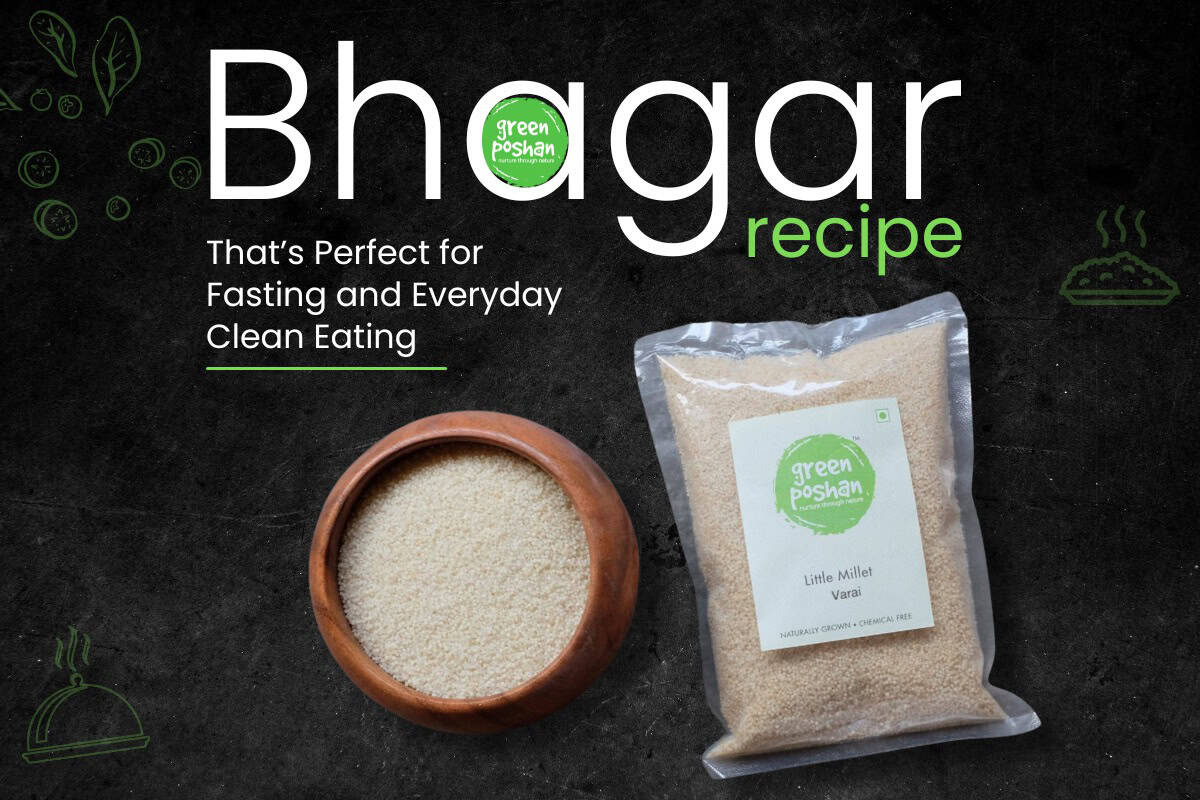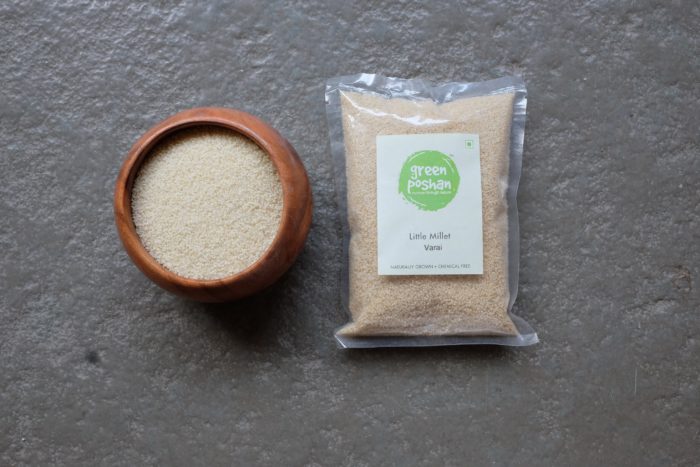What is Bhagar and Why Is It Popular During Fasting?
Bhagar, also known as barnyard millet or vrat ke chawal, is a tiny, white, gluten-free grain traditionally consumed during Indian fasting festivals like Navratri, Ekadashi, and Shravan. Its sattvic nature makes it ideal for those seeking light and nourishing meals during vrat.
But bhagar is more than just a fasting food. It’s a powerhouse of nutrition—rich in fiber, iron, and antioxidants—and can be a regular part of any clean-eating diet. Whether you’re cutting down on rice or avoiding gluten, this versatile grain is worth a place in your kitchen.
Bhagar Recipe (Vrat-Friendly and Gluten-Free)
This simple bhagar recipe is quick to prepare, delicious, and suitable for both fasting days and light everyday meals. It’s made using naturally grown bhagar from Green Poshan, cold-pressed oil or ghee, and a few humble spices.
Ingredients:
- 1 cup Green Poshan Bhagar (Barnyard Millet)
- 1/4 cup roasted peanuts (crushed)
- 2 tablespoons ghee or cold-pressed groundnut oil
- 1 teaspoon cumin seeds
- 1–2 green chilies (slit)
- 1 medium boiled potato (cubed)
- Sendha namak (rock salt) to taste
- Fresh coriander leaves (chopped)
- 2 to 2.5 cups water
- 1 teaspoon lemon juice (optional)
How to Make Bhagar Khichdi:
- Wash and soak the bhagar for 15 minutes. Drain and set aside.
- Heat ghee or oil in a pan. Add cumin seeds and let them splutter.
- Add chilies and potatoes, sauté for 2–3 minutes.
- Add the soaked bhagar and mix well to coat the grains with ghee/oil.
- Pour in water and salt, stir once, cover the lid, and cook on low flame for 8–10 minutes or until the water is absorbed.
- Add crushed peanuts and coriander, mix gently. Add lemon juice if desired and serve hot.
This bhagar recipe yields a soft, fluffy, and mildly spiced dish that pairs beautifully with curd, cucumber raita, or peanut chutney.
Bhagar vs Sabudana – Which Is a Better Choice for Fasting?
Both bhagar and sabudana are popular vrat foods, but they differ significantly in terms of nutrition and digestibility.
| Feature | Bhagar (Barnyard Millet) | Sabudana (Tapioca Pearls) |
| Nutrient Value | High in fiber, iron, and protein | High in starch, low in fiber |
| Digestion | Light and easy to digest | Can cause bloating |
| Glycemic Index | Low | High |
| Satiety | Keeps you full longer | May lead to quick hunger |
| Fasting Compatibility | Gluten-free, sattvic | Fasting-friendly but heavy |
| Cooking Versatility | Can be used for khichdi, tikkis | Mostly limited to khichdi, vada |
Conclusion: If you’re looking for a healthier alternative to sabudana, especially for long fasting days, bhagar is more nutritious, gut-friendly, and keeps you full longer.
Why Choose Green Poshan Bhagar?
Green Poshan brings you naturally grown bhagar, sourced directly from farmers using traditional, chemical-free methods. Our grains are:
- 100% natural and unpolished
- Triple-cleaned and hand-sorted
- Free from additives and artificial treatments
- Processed by women-led cottage industries
Choosing Green Poshan is not just good for your health—it also supports sustainable agriculture and rural women entrepreneurs.
Little Millet (Varai) — 250g
Little Millets, also known as Varai Millets in many parts of India, are among the smallest yet most nutrient-dense grains found in traditional Indian food culture. These tiny grains pack a remarkable punch when it comes to health benefits, making them a wise addition to modern, health-focused diets. Green Poshan brings to you naturally sourced, minimally processed Little Millets (Varai) to support everyday wellness through traditional nutrition.
Naturally gluten-free and easy to digest, Varai Millets are often used during religious fasting and are celebrated for their lightness and nutritional profile. They cook quickly, taste mildly nutty, and are perfect for porridge, upma, pulao, and even dosa batters. Whether you’re looking to manage weight, support digestion, or include ancient grains in your routine, Little Millets are a reliable and wholesome option.
Order now and make your fasting meals healthier with Green Poshan Bhagar.
Pro Tips to Make the Most of Your Bhagar Recipe
- Always soak bhagar for 10–15 minutes to improve texture.
- For a richer taste, use desi ghee over oil.
- Add curry leaves or ginger for added flavor during non-fasting days.
- Pair with chilled curd or cucumber raita for a complete sattvic thali.
This bhagar recipe is a beautiful blend of simplicity, taste, and nutrition. Whether you’re fasting during Navratri, Ekadashi, or just looking for a gluten-free grain for daily use, bhagar is the perfect choice. With Green Poshan’s naturally grown bhagar, you can enjoy the authentic taste of tradition with the assurance of purity and health.
Ready to try it? Make bhagar a staple in your kitchen—not just for vrat, but for every clean and conscious meal.


